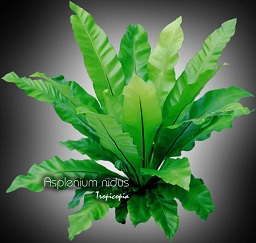Table of contents
Birdnest fern

Latin Name: Asplenium nidus
Category: Fern
Family: Aspleniaceae
Origin: Asia
Climate: Tropical humid
Growing Zones: 11-10
Care Instructions
The Birdnest fern (Asplenium nidus) is a tropical humid plant that originates from Asia. This fern plant belongs to the Aspleniaceae family and is well-suited for growing in USDA zones 11-10.
Complete Care Guide for Birdnest Fern (Asplenium nidus)
Watering Requirements
The Birdnest Fern thrives in a humid environment and requires consistent moisture to flourish. Water the plant when the top inch of the soil feels dry to the touch, typically every 1-2 weeks, depending on the humidity and temperature of your environment. It is crucial to avoid overwatering, as this can lead to root rot. Ensure that the pot has good drainage to allow excess water to escape. During the growing season (spring and summer), you may need to increase the frequency of watering, while in the dormant season (fall and winter), reduce watering slightly. Additionally, misting the leaves regularly can help maintain humidity levels, which is beneficial for the fern’s overall health.
Light Conditions
Birdnest Ferns prefer bright, indirect light but can also tolerate low light conditions. Direct sunlight can scorch the leaves, leading to brown tips and edges. Ideally, place your fern near a window with filtered light or in a well-lit room where it can receive dappled sunlight. If you notice the leaves becoming leggy or losing their vibrant green color, it may be a sign that the plant is not receiving enough light. Conversely, if the leaves are turning yellow or brown, consider moving it to a location with less direct sunlight. Maintaining the right light conditions is essential for promoting healthy growth and lush foliage.
Soil Preferences
The ideal soil for a Birdnest Fern is a well-draining, organic potting mix that retains moisture without becoming waterlogged. A blend of peat moss, perlite, and orchid bark works well, providing the necessary aeration and drainage. This fern does not thrive in heavy, compacted soils, so it is essential to choose a mix that allows for good airflow to the roots. Fertilization should be done sparingly; use a balanced, water-soluble fertilizer diluted to half strength every 4-6 weeks during the growing season. Avoid fertilizing in the fall and winter when the plant is dormant, as this can lead to nutrient buildup and potential root damage.
Pests and Diseases
Birdnest Ferns are generally resilient but can be susceptible to common pests such as spider mites, mealybugs, and scale insects. Regularly inspect the undersides of the leaves and the stems for any signs of infestation. If you notice pests, treat them promptly with insecticidal soap or neem oil, ensuring to follow the product instructions carefully. Additionally, maintaining proper humidity levels can help deter pests, as they thrive in dry conditions. Fungal diseases can also occur, particularly if the plant is overwatered or if there is poor air circulation. To prevent this, ensure that the fern is not sitting in water and that it has adequate airflow around it. If you notice any signs of disease, such as wilting or discoloration, remove affected leaves and adjust your care routine accordingly.
Special Care Tips
To keep your Birdnest Fern healthy and thriving, consider the following special care tips: First, ensure that the plant is not exposed to cold drafts or sudden temperature changes, as this can stress the fern. Ideal temperatures range from 60°F to 75°F (15°C to 24°C). Additionally, repot your fern every couple of years to refresh the soil and provide more space for growth. When repotting, choose a pot that is only slightly larger than the current one to avoid overpotting, which can lead to excess moisture retention. Lastly, be mindful of the humidity levels in your home; if the air is particularly dry, consider using a humidifier or placing a tray of water with pebbles beneath the pot to increase humidity around the plant. With these care tips, your Birdnest Fern will not only survive but thrive, showcasing its beautiful, lush foliage.








